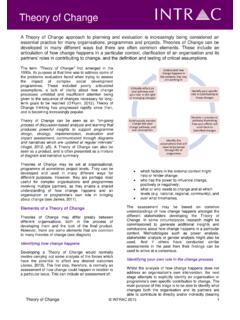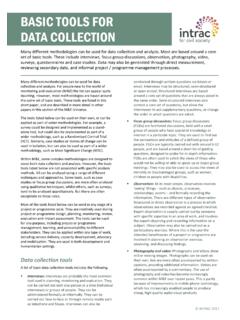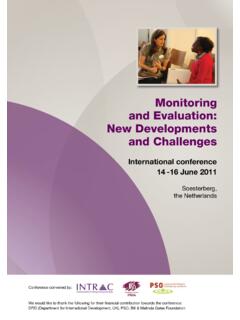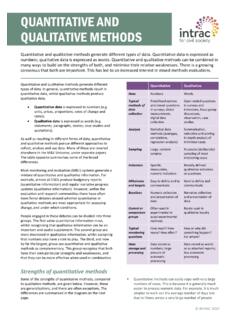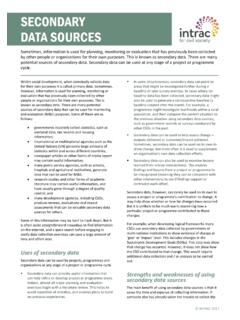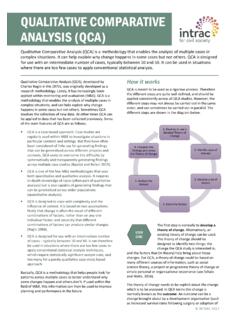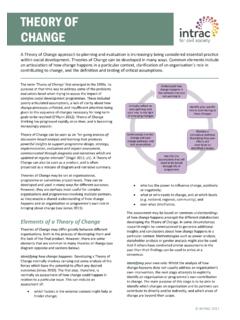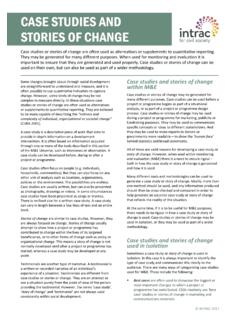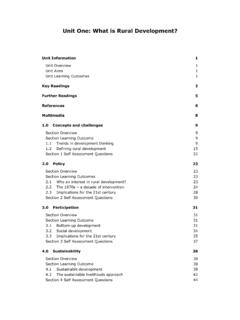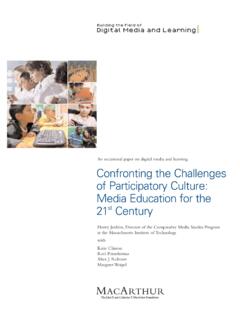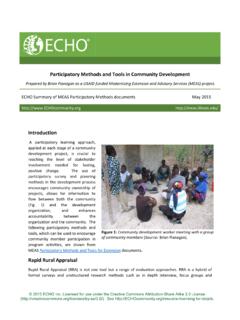Transcription of PARTICIPATORY LEARNING AND ACTION (PLA)
1 INTRAC 2017 PARTICIPATORY LEARNING AND ACTION (PLA) PARTICIPATORY LEARNING and ACTION (PLA) is a type of qualitative research. It is used to gain an in-depth understanding of a community or situation, and is always conducted with the full and active participation of community members. PLA is applied through a range of PARTICIPATORY tools and approaches. It is also a philosophy that emphasises reversals in power relations between communities and outsiders. PARTICIPATORY LEARNING and ACTION (PLA) is a type of qualitative research, which can be used to gain an in-depth understanding of a community or situation. It is widely used in work involving local communities. PLA is a PARTICIPATORY methodology, and should always be conducted with the full and active participation of community members.
2 The main purpose of PLA is to support people within communities to analyse their own situation, rather than have it analysed by outsiders, and to ensure that any LEARNING is then translated into ACTION (Gosling and Edwards 2003). PLA was originally called PARTICIPATORY rural (or Rapid) Appraisal (PRA). It became very popular in the 1980s and 1990s, and has since kept its popularity with many CSOs. PRA was originally designed for use during appraisals and needs assessments in rural areas. However, it can be used at any stage of the project cycle design, planning, monitoring, review and evaluation and is now used in urban as well as rural areas. The name was changed to PARTICIPATORY LEARNING and ACTION (PLA) to reflect its broader application, and to emphasise that the process is designed to help set in motion locally-led ACTION .
3 PLA can be described in two different, complementary ways. Firstly, it is a philosophy and a way of thinking that emphasises reversals in power relations between communities and outsiders (such as researchers, evaluators or programme planners). Secondly, it covers a range of PARTICIPATORY tools and approaches that can be used to work, plan and reflect with and alongside communities. PLA as a philosophy PLA is located within a broader field of PARTICIPATORY approaches, which can be described as a family of approaches, methods, attitudes and behaviours to enable and empower people to share, analyse and enhance their knowledge of life and conditions, and to plan, act, monitor, evaluate and reflect (Chambers 2008).
4 In its pure form, PLA is a philosophy which emphasises the need for outsiders to learn about situations from insiders. This philosophy seeks to reverse power relations between communities and outsiders. It grew partly in reaction to the top-down planning methodologies of the 1960s and 1970s. The fundamental idea of PLA is that communities are supported to analyse their own situation, make decisions about how to best tackle their problems, and, as a result, feel empowered to take ACTION . However, although the reversal of power relations is considered an important part of PLA, it is not always applied in this way. PLA is frequently if incorrectly used for studies that extract data from communities, but do not empower them to use that data.
5 Some of the principles of PLA, derived from the PARTICIPATORY philosophy, are described in the box below. Principles of PLA PLA is designed to seek out multiple perspectives and embrace diversity. It is based around group analysis and LEARNING . It is designed to be flexible, adaptive and innovative, rather than conforming to top-down or rigid methods of data collection and analysis. PLA is designed to encourage people to discuss issues, errors and mistakes in a non-judgemental environment. High ethical standards should always be applied within PLA. PLA facilitators should act as catalysts rather than as trainers or teachers. The languages and concepts of PLA should reflect the way a community thinks, rather than reflecting how those seeking the information think.
6 This means the language and concepts of PLA should be appropriate to the local culture and context. PLA is designed to seek out the voices and opinions of the most marginalised communities and people, such as children, women, people of lower caste or status, or people with disabilities. PLA is based around triangulation. This means accessing information about the same things in different ways, and from different sources, to ensure it is reliable, and that different viewpoints are recognised. PLA is facilitated by multi-disciplinary teams, including people with different skills and different views. Teams should include members of the communities as well as outsiders. PLA is designed to provide insights and understanding that helps guide community development, rather than providing evidence that would be seen as rigorous in an academic article.
7 Analysis and validation is done in real-time with communities. In PLA, teams review findings with communities on a regular basis, and validate data with communities before progressing. INTRAC 2017 How it works PLA is designed to be a truly participative process, in which communities have significant influence over how work is carried out. This means it is not possible (or desirable) to provide a standardised methodology or process. However, the following steps are usually included. Firstly, the goals and objectives of the PLA work are clarified and agreed with the communities. If there are multiple or conflicting goals then issues are resolved before proceeding. The goals and objectives should reflect the communities needs as much as, if not more than, the needs of the outsiders.
8 Next, a set of relevant tools and approaches are selected. PLA comprises many different tools and approaches, some of which are described in the next section. The tools and approaches should be applied in a PARTICIPATORY manner. Often, this involves a series of exercises, carried out in the field. These exercises are normally carried out with the help of a trained facilitator. Any information acquired through the tools and approaches is triangulated (cross-checked) and is validated by the community. In PLA, data analysis is done cumulatively in the field by community members and facilitators. PLA contains no specific methods for analysis, but it is important that any analysis methods used can be applied by community members.
9 Analysis typically includes the identification of connections, relationships, gaps, contradictions and new areas of inquiry. Often this is based around: interpreting descriptions, stories, statements, pictures, maps, diagrams and other visual data; identifying themes and patterns emerging out of the data collection; assessing the frequency with which particular ideas or themes are mentioned; testing the strength of feeling about specific issues; identifying points of convergence or divergence between different sets of data, collected through different sources, methods and perspectives; and identifying gaps in the data where further information needs to be collected, or where more probing of existing data is needed.
10 Two important concepts in PLA are optimal ignorance and appropriate imprecision (Chambers 1983). These mean that people involved in PLA should only collect and analyse information that is needed, to the level of accuracy needed to inform decision-making and ACTION in the community. This contrasts with many M&E and research methodologies which are aimed at establishing findings to very high levels of precision to meet the demands of academic audiences. When the point of optimal ignorance is reached, the next step is to develop a community ACTION plan, or for the community to take specific ACTION based on the analysis. Often, this means presenting work in different ways to different audiences, such as community leaders, community-based organisations (CBOs), local government agencies or other potential service providers.

